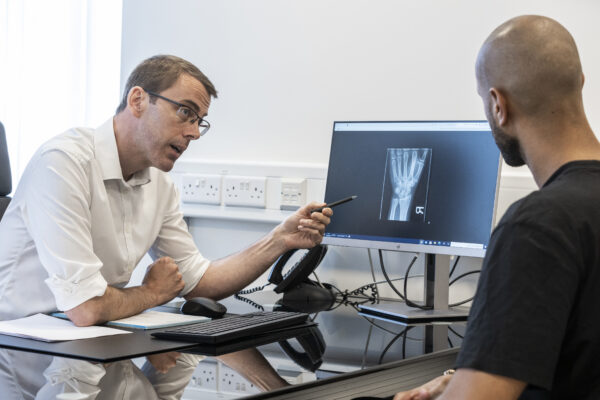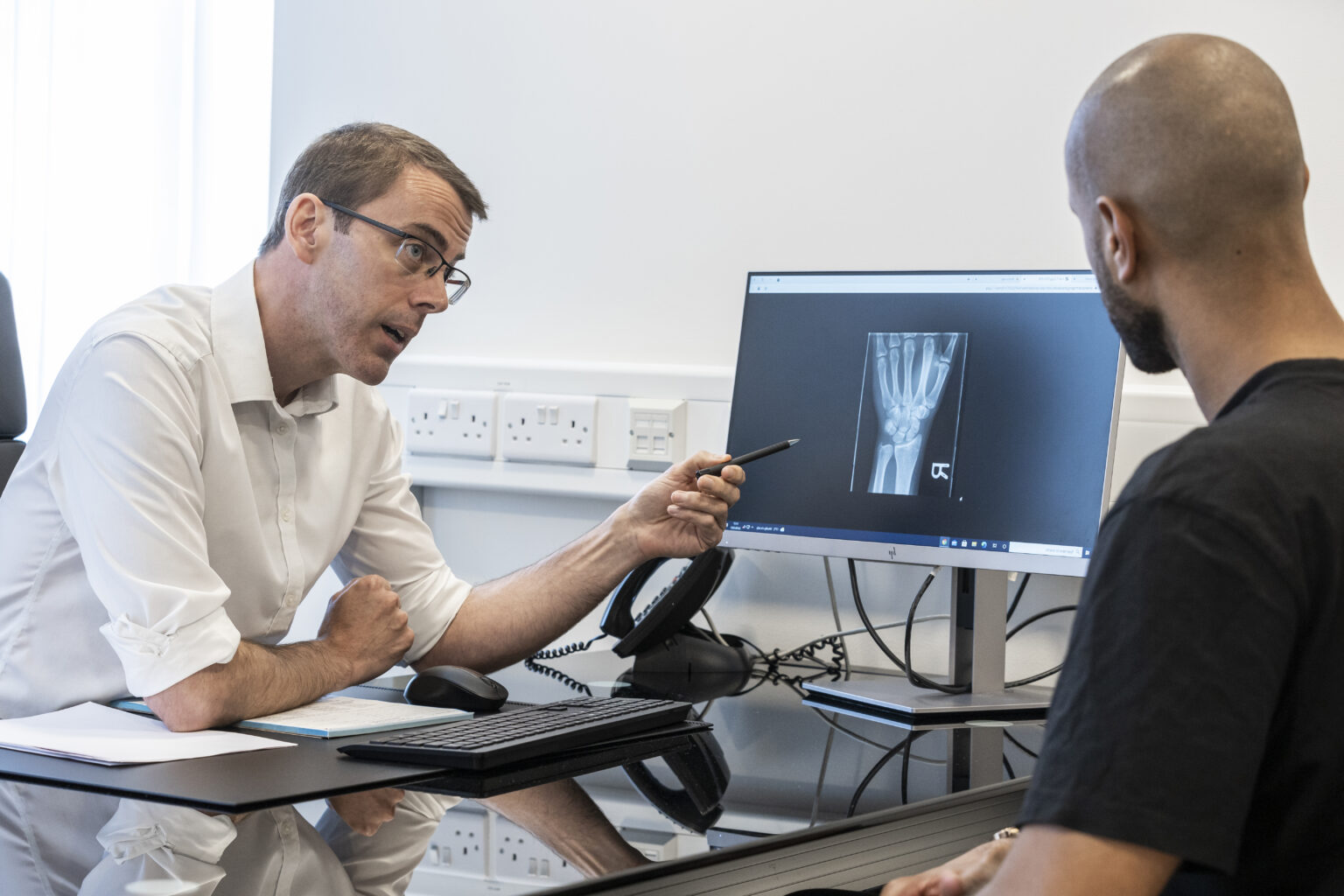Contact number: 020 7806 4060
Treatment for carpal tunnel syndrome
Carpal tunnel is a very common condition caused by pressure on the median nerve, which is one of the main nerves in the hand. The median nerve enters the hand through the carpal tunnel, which is a small space in the wrist. If the tissue inside the carpal tunnel becomes inflamed and swells, it can put pressure on the median nerve, causing pain and numbness.
In most patients, the cause of CTS is not clear. However, you’re at a higher risk if you are pregnant, have diabetes or a low thyroid condition, or have arthritis in the wrist.
Milder cases can often be managed without surgery and conservative treatment options are available such as:
- Avoiding activities that trigger symptoms.
- Wearing a wrist splint at night.
- Corticosteroid injections, which can provide temporary relief and are performed quickly in our outpatient clinic.
If symptoms worsen or other treatments are unsuccessful, carpal tunnel release surgery may be needed.
What is carpal tunnel release surgery?
Carpal tunnel release surgery is a minimally invasive procedure that involves cutting the ligament pressing on the median nerve to relieve pressure. This allows the nerve to heal and restores normal sensation and movement in the hand. The procedure is typically recommended for patients with persistent symptoms of carpal tunnel syndrome that have not improved with non-surgical treatments, such as splinting or steroid injections.
Why have carpal tunnel release surgery?
Carpal tunnel release surgery is a highly effective treatment for carpal tunnel syndrome, a condition that causes pain, numbness, and weakness in the hand and fingers. If left untreated, symptoms can worsen over time, potentially leading to permanent nerve damage and loss of function.
Surgery relieves pressure on the median nerve by cutting the transverse carpal ligament, creating more space within the carpal tunnel. This helps to:
- Reduce pain, tingling, and numbness in the fingers and hand
- Restore strength and function, making everyday tasks easier
- Prevent long-term nerve damage, which can occur if the condition progresses
- Provide lasting relief, especially for those who have not responded to non-surgical treatments
At St John & St Elizabeth Hospital in NW London, our expert hand surgeons use minimally invasive techniques to promote a faster recovery with minimal scarring. With state-of-the-art facilities and personalised care, we help you regain comfort and movement as quickly as possible.
What to expect during carpal tunnel surgery
The procedure takes 10–20 minutes and is usually done under local anaesthetic. A small incision is made at the base of the palm, and the surgeon releases the transverse carpal ligament to relieve pressure on the nerve. The incision is closed with stitches, and a dressing and bandage are applied. You will return home the same day and will need someone to accompany you as you won’t be able to drive.
What is recovery like after carpal tunnel release surgery?
Recovery from carpal tunnel release surgery involves rest, keeping the hand elevated to reduce swelling, and gentle hand exercises. Most patients can return to light activities within one to two weeks, with full recovery typically taking six to eight weeks. Recovery includes:
- Wearing a bulky bandage for a few days to a week.
- Avoiding heavy lifting and keeping the wound dry for at least two weeks.
- Taking over-the-counter painkillers if needed.
You’ll have a follow-up appointment after two weeks to remove stitches and start light hand exercises. Full recovery, including resolving pins and needles, may take three months, with some residual numbness settling over six months to a year.
Carpal Tunnel Release Surgery Explained – watch our video
In this video, Mr Michael Elvy, Orthopaedic Hand and Wrist Surgeon at St John & St Elizabeth Hospital, discusses the condition of carpal tunnel syndrome and the surgical option at St John & St Elizabeth Hospital.
Consultants who perform Carpal Tunnel Release Surgery in London
How Much Does Private Carpal Tunnel Release Surgery Cost?
£1,780
Carpal Tunnel Release Surgery costs £1,780 at St John & St Elizabeth Hospital.
This price will include all costs associated with your treatment, from admission to discharge, but doesn’t include the surgeon or anaesthetist fee.
Hospital Fee Guaranteed: Our hospital fee is guaranteed at the price quoted and valid for one month from the date issued, subject to pre-assessment.
How to pay for your treatment
If you’re… paying for yourself
Did you know you don’t need private medical insurance to come to St John & St Elizabeth Hospital? As a self-pay patient, you can access safe, outstanding quality health care at times to suit you.
For scans and tests, as well as to see most consultants, you’ll still need to be referred by a medical professional like your GP, but as a self-pay patient, the process is more straightforward. You won’t need authorisation from an insurance provider, and you’ll have greater choice of consultant and appointment times.
If you’re… insured
St John & St Elizabeth Hospital is approved by all major medical insurance companies. If you have a personal private health insurance policy, or your company provide it for you, you can use it to pay for your care from your initial consultation through to treatment, surgery and aftercare such as physiotherapy. Not all private health insurance plans cover the same things. It’s very important to check exactly what you are covered for with your insurance provider.
More FAQs about carpal tunnel surgery
St John & St Elizabeth Hospital is located in St John’s Wood (NW8), a well-connected area of North West London. We are conveniently accessible for patients from Hampstead (NW3), Kilburn (NW6), and beyond.
By Tube:
- St John’s Wood station (Jubilee Line) is just a 5-minute walk from the hospital.
- Finchley Road (NW3) and Kilburn stations (NW6) on the Jubilee Line provide excellent connections.
By Bus:
-
- Wellington Road: Routes 13, 46, 82, and 113 stop near St John’s Wood Underground Station, just a short walk from the hospital.
- Circus Road: Routes 46 and 187 stop close to the hospital’s Circus Road entrance.
- Abbey Road: Routes 139 and 189 stop near the junction where Grove End Road becomes Abbey Road, providing easy access.
Major Roads:
If you’re travelling from NW3 or NW6, major routes such as Finchley Road or Kilburn High Road offer a direct approach to the hospital.
Our hospital ensures convenient access for patients across London, particularly those in NW8, NW3, and NW6 postcodes.
When the median nerve is under pressure, it can cause a number of symptoms. In milder cases, these can come and go with time and often flare up at night or first thing in the morning. In more moderate or severe cases, the symptoms can be present all the time, day and night. They can also come on with certain activities, such as holding a phone or reading a paper/electronic device.
The classic symptoms are:
- An ache or pain in your fingers, hand and sometimes arm
- Numbness in the hand
- Burning, tingling or pins and needles in the fingers – usually the thumb, index, middle and ring
- Weakness in the hand or difficulty gripping
Your doctor will examine the feeling in your fingers and the strength of your hand muscles. They may assess your wrist by bending, tapping, or pressing on it to confirm a diagnosis. In some cases, a nerve conduction study may be recommended. This measures electrical pulses in your nerves and muscles to diagnose carpal tunnel or rule out other conditions.
- Desk jobs: 2–3 weeks.
- Manual labour: Avoid heavy lifting for at least two weeks.
- Driving: Usually safe after 7–10 days, with your doctor’s advice.
- Sports: Light activities are fine after 10 days, but avoid heavy exercises or lifting for longer. Always consult your doctor for guidance.
The surgery is performed under local or general anaesthesia, so you won’t feel pain during the procedure. Some discomfort may be experienced as the hand heals, but this can be managed with medication and care instructions from your surgeon.
Carpal tunnel release surgery is generally safe, but like any procedure, it carries some risks, such as infection, nerve damage, or temporary stiffness. Your consultant will discuss these risks with you before surgery.
Medically reviewed by Mr Alistair Hunter - MA MBBS MSc FRCS (Tr&Orth) FHEA Dip Hand Surg on 13/11/2023


